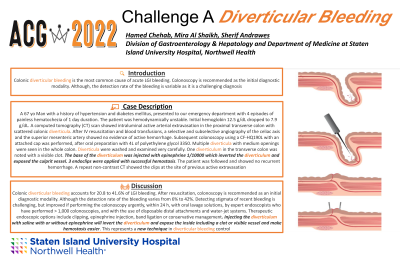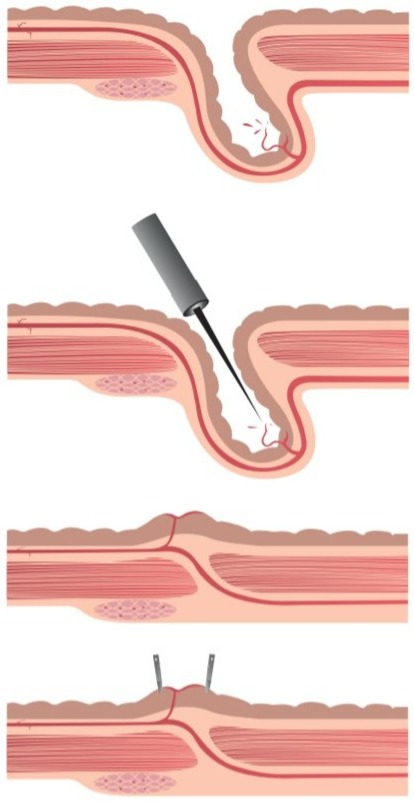Back


Poster Session D - Tuesday Morning
Category: GI Bleeding
D0341 - Challenge a Diverticular Bleeding
Tuesday, October 25, 2022
10:00 AM – 12:00 PM ET
Location: Crown Ballroom

Has Audio

Hamed Chehab, MD
Staten Island University Hospital
Staten Island, NY
Presenting Author(s)
Mira Asheikh, MD, Sherif Andrawes, MD, Hamed Chehab, MD
Staten Island University Hospital, Staten Island, NY
Introduction: Colonic diverticular bleeding is the most common cause of acute LGI bleeding. Colonoscopy is recommended as the initial diagnostic modality. Although, the detection rate of the bleeding is variable as it is a challenging diagnosis
Case Description/Methods: A 67 yo Man with a history of hypertension and diabetes mellitus, on baby aspirin presented to our emergency department with 4 episodes of painless hematochezia of 1day duration. The patient was initially stable but blood pressure dropped to 74/52 mmHg with continuous bleeding. Initial hemoglobin 12.5 g/dL dropped to 7.9 g/dL. A computed tomography (CT) scan showed intraluminal active arterial extravasation in the proximal transverse colon with scattered colonic diverticula. After IV resuscitation and blood transfusions, a selective and subselective angiography of the celiac axis and the superior mesenteric artery showed no evidence of active hemorrhage. Subsequent colonoscopy using a CF-HQ190L with an attached cap was performed, after oral preparation with 4L of polyethylene glycol 3350. Multiple diverticula with medium openings were seen in the whole colon. Diverticula were washed and examined very carefully. One diverticulum in the transverse colon was noted with a visible clot. The base of the diverticulum was injected with epinephrine 1/10000 which inverted the diverticulum and exposed the culprit vessel. 3 endoclips were applied with successful hemostasis. The patient was followed and showed no recurrent hemorrhage. A repeat non-contrast CT showed the clips at the site of previous active extravasation.
Discussion: Colonic diverticular bleeding accounts for 20.8 to41.6% of LGI bleeding. After resuscitation, colonoscopy is recommended as an initial diagnostic modality. Although the detection rate of the bleeding varies from 6% to 42%. Detecting stigmata of recent bleeding is challenging, but improved if performing the colonoscopy urgently, within 24 h, with oral lavage solutions, by expert endoscopists who have performed > 1,000 colonoscopies, and with the use of disposable distal attachments and water-jet systems. Having CT angio ahead of time is beneficial as it guides us anatomically. Therapeutic endoscopic options include clipping, epinephrine injection, band ligation or conservative management. Injecting the diverticulum with saline with or without epinephrine will invert the diverticulum and expose the inside including a clot or visible vessel and make hemostasis easier. This represents a new technique in diverticular bleeding control.

Disclosures:
Mira Asheikh, MD, Sherif Andrawes, MD, Hamed Chehab, MD. D0341 - Challenge a Diverticular Bleeding, ACG 2022 Annual Scientific Meeting Abstracts. Charlotte, NC: American College of Gastroenterology.
Staten Island University Hospital, Staten Island, NY
Introduction: Colonic diverticular bleeding is the most common cause of acute LGI bleeding. Colonoscopy is recommended as the initial diagnostic modality. Although, the detection rate of the bleeding is variable as it is a challenging diagnosis
Case Description/Methods: A 67 yo Man with a history of hypertension and diabetes mellitus, on baby aspirin presented to our emergency department with 4 episodes of painless hematochezia of 1day duration. The patient was initially stable but blood pressure dropped to 74/52 mmHg with continuous bleeding. Initial hemoglobin 12.5 g/dL dropped to 7.9 g/dL. A computed tomography (CT) scan showed intraluminal active arterial extravasation in the proximal transverse colon with scattered colonic diverticula. After IV resuscitation and blood transfusions, a selective and subselective angiography of the celiac axis and the superior mesenteric artery showed no evidence of active hemorrhage. Subsequent colonoscopy using a CF-HQ190L with an attached cap was performed, after oral preparation with 4L of polyethylene glycol 3350. Multiple diverticula with medium openings were seen in the whole colon. Diverticula were washed and examined very carefully. One diverticulum in the transverse colon was noted with a visible clot. The base of the diverticulum was injected with epinephrine 1/10000 which inverted the diverticulum and exposed the culprit vessel. 3 endoclips were applied with successful hemostasis. The patient was followed and showed no recurrent hemorrhage. A repeat non-contrast CT showed the clips at the site of previous active extravasation.
Discussion: Colonic diverticular bleeding accounts for 20.8 to41.6% of LGI bleeding. After resuscitation, colonoscopy is recommended as an initial diagnostic modality. Although the detection rate of the bleeding varies from 6% to 42%. Detecting stigmata of recent bleeding is challenging, but improved if performing the colonoscopy urgently, within 24 h, with oral lavage solutions, by expert endoscopists who have performed > 1,000 colonoscopies, and with the use of disposable distal attachments and water-jet systems. Having CT angio ahead of time is beneficial as it guides us anatomically. Therapeutic endoscopic options include clipping, epinephrine injection, band ligation or conservative management. Injecting the diverticulum with saline with or without epinephrine will invert the diverticulum and expose the inside including a clot or visible vessel and make hemostasis easier. This represents a new technique in diverticular bleeding control.

Figure: Diverticular bleeding control
Disclosures:
Mira Asheikh indicated no relevant financial relationships.
Sherif Andrawes indicated no relevant financial relationships.
Hamed Chehab indicated no relevant financial relationships.
Mira Asheikh, MD, Sherif Andrawes, MD, Hamed Chehab, MD. D0341 - Challenge a Diverticular Bleeding, ACG 2022 Annual Scientific Meeting Abstracts. Charlotte, NC: American College of Gastroenterology.
